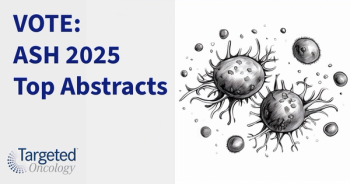
Tumor Regression Is Observed With Neoadjuvant Atezolizumab in Resectable NSCLC
In patients with non–small cell lung cancer who were eligible for surgical resection, treatment with one dose of neoadjuvant atezolizumab was considered safe and induced major pathological responses in some patients.
In patients with non–small cell lung cancer (NSCLC) who were eligible for surgical resection, treatment with one dose of neoadjuvant atezolizumab (Tecentriq) was considered safe and induced major pathological responses (MPR) in some patients, according to Benjamin Besse, MD, PhD, who presented data from the phase 2 PRINCEPS trial (NCT02994576) during the European Society for Medical Oncology Virtual Congress 2020.
Four of 30 patients (14%) who received treatment with the neoadjuvant PD-L1 inhibitor experienced an MPR, defined as having less than 10% of residual tumor cells after treatment. An additional 12 patients (41%) had a pathological response that was seen in more than 50% of tumor cells.
“MPR is a surrogate end point for survival for neoadjuvant chemotherapy,” said Besse, who is the Cancer Medicine Department Head at the Gustave Roussy Cancer Centre in Paris and professor of medical oncology at Paris-Sud University in Orsay, France. “This is the first study with such a short time between one injection of immunotherapy and surgery. It was safe and did not impair surgery.”
All patients treated on the trial (n = 30) received the atezolizumab dose and had surgery with safety analysis performed 1 month after surgery. The median time between the atezolizumab dose and surgery was 24 days, with no patients experiencing a delay of greater than 15 days. Most patients (93%) had a lobectomy and R0 quality of resection (97%). One-third of patients (29.7) received adjuvant radiotherapy.
Seven patients (23%) had complications within 1 month of surgery; however, there were no grade 4 or 5 complications. “Mostly, [patients had] atrial fibrillation or infection,” Besse said. “This rate of complications is what was expected of this population.”
There was a correlation between high PD-L1 status before treatment and pathological regression of the tumor (P = .0311). Patients with 50% or greater PD-L1 expression at baseline saw the greatest degree of tumor pathological response.
Responses according to RECIST 1.1 were observed in 2 out of 29 evaluable patients (7%) and were comprised of exclusively partial responses. Stable disease was seen in 27 patients (93%) and no progression events were reported. There was no correlation between the degree of pathological regression of the tumor and tumor response per CT scan at 3 weeks post-atezolizumab injection (P = .2).
Tumor samples collected during surgery and analyzed by flow cytometry revealed a correlation between PD-L1 and TIGIT expression on lymphocytes.
By 18F-FDG-PET scan, 7 patients (25%) had a 20% or greater increase in the maximum standardized uptake volume (SUVmax) as compared with baseline versus 3 (11%) who saw a 20% or greater decrease. There was no correlation between the degree of pathological regression of the tumor and variation of SUVmax at 3 weeks post-atezolizumab injection (P = .55).
“One of the patients had 400% increase of the SUVmax, and in fact, this was linked to a pathological response in 80% of [tumor] cells,” Besse said.
The trial included patients with cytologically or histologically confirmed stage I to IIIA NSCLC who were unselected for PD-L1. All patients had imaging, immune monitoring, and PD-L1 expression assessment at screening. Atezolizumab 1200 mg was administered once followed by surgery at week 4. One week prior to surgery, imaging and immune monitoring was repeated; PD-L1 expression assessment was repeated upon surgical resection of the patient’s tumor. Chest and abdominal CT scans were repeated every 6 months for 5 years following surgery. Patients were allowed to received adjuvant treatment, based on the standard of care.
The primary end point of the trial was safety, defined as the rate of patients without major toxicity or morbidity between the start of treatment to 1 month following surgery, or the 2-month tolerance rate. Toxicity leading to at least a 15-day delay in surgery, grade 3 or greater treatment-related adverse events, major postoperative morbidity, and death related to experimental treatment within the 2-month treatment period or early progression leading to surgery cancellation were all included as major events of toxicity and morbidity. Secondary outcome measures included response rates, overall and disease-free survival, pathological complete response, pathological findings, and response by 18F-FDG-PET. Exploratory end points included PD-L1 expression, immune response, and molecular profiling at resection.
Baseline characteristics included a median age of 64 years with half of patients (50%) being men. ECOG performance status was 1 in 77% of patients, most (93%) were current or former smokers, and half (50%) were assessed as have pathological stage I disease. The most common mutation observed was TP53 in 13 patients, followed by KRAS in 8, EGFR in 3, BRAF in 2, and PI3KCA, STK11, ESR1, and WT in 1 each. PD-L1 expression status at baselines was less than 1% in 18 patients, 1% of greater in 6, and 50% or greater in 5.
The initial trial was a Simon design with an end point of the 2-month tolerance rate (absence of severe toxicity/morbidity), where P0 is equal to 60%, and P1 is equal to 80% (one-sided a = 80%, power = 95%). The trial was amended due to an absence of safety concerns and the number of patients enrolled to receive the experimental treatment was reduced from 60 to 30, with a power level lower than 95%. A control group of 30 patients who will not receive neoadjuvant therapy was created and will be treated by a similar screening and monitoring process.
“Recruitment of the control group of 30 patients with untreated tumors is ongoing, and the final analysis of the immune contexture in blood and fresh tissue will be performed when the control group is fully recruited,” Besse concluded.
Reference
Besse B. Neoadjuvant atezolizumab (A) for resectable non-small cell lung cancer (NSCLC): results from the phase II PRINCEPS trial. Poster. European Society of Medical Oncology (EMSO) 2020 Virtual Congress; September 17-21, 2020. Abstract 1215O.









































